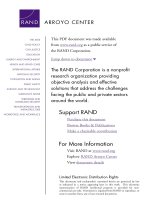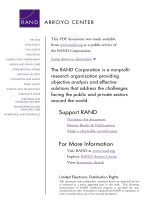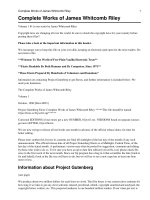Jit implementation manual the complete guideto justin time manufacturing second edition vol 4
Bạn đang xem bản rút gọn của tài liệu. Xem và tải ngay bản đầy đủ của tài liệu tại đây (5.89 MB, 189 trang )
JIT Implementation Manual
The Complete Guide to
Just-in-Time Manufacturing
Second Edition
Volume 4
JIT Implementation Manual
The Complete Guide to
Just-in-Time Manufacturing
Second Edition
Volume 4
Leveling –
Changeover and Quality Assurance
HIROYUKI HIRANO
Originally published as Jyasuto in taimu seisan kakumei shido manyuaru copyright © 1989 by JIT Management Laboratory Company, Ltd., Tokyo,
Japan.
English translation copyright © 1990, 2009 Productivity Press.
CRC Press
Taylor & Francis Group
6000 Broken Sound Parkway NW, Suite 300
Boca Raton, FL 33487-2742
© 2009 by Taylor & Francis Group, LLC
CRC Press is an imprint of Taylor & Francis Group, an Informa business
No claim to original U.S. Government works
Printed in the United States of America on acid-free paper
10 9 8 7 6 5 4 3 2 1
International Standard Book Number-13: 978-1-4200-9028-4 (Softcover)
This book contains information obtained from authentic and highly regarded sources. Reasonable efforts have been made to publish reliable data and
information, but the author and publisher cannot assume responsibility for the validity of all materials or the consequences of their use. The authors and
publishers have attempted to trace the copyright holders of all material reproduced in this publication and apologize to copyright holders if permission
to publish in this form has not been obtained. If any copyright material has not been acknowledged please write and let us know so we may rectify in any
future reprint.
Except as permitted under U.S. Copyright Law, no part of this book may be reprinted, reproduced, transmitted, or utilized in any form by any electronic,
mechanical, or other means, now known or hereafter invented, including photocopying, microfilming, and recording, or in any information storage or
retrieval system, without written permission from the publishers.
For permission to photocopy or use material electronically from this work, please access www.copyright.com ( or contact
the Copyright Clearance Center, Inc. (CCC), 222 Rosewood Drive, Danvers, MA 01923, 978-750-8400. CCC is a not-for-profit organization that provides
licenses and registration for a variety of users. For organizations that have been granted a photocopy license by the CCC, a separate system of payment
has been arranged.
Trademark Notice: Product or corporate names may be trademarks or registered trademarks, and are used only for identification and explanation without intent to infringe.
Visit the Taylor & Francis Web site at
and the CRC Press Web site at
Contents
Volume 1
1.
Production Management and JIT Production Management....... 1
Approach to Production Management................................................... 3
Overview of the JIT Production System................................................ 7
Introduction of the JIT Production System...........................................12
2.
Destroying Factory Myths: A Revolutionary Approach............ 35
Relations among Sales Price, Cost, and Profit......................................35
Ten Arguments against the JIT Production Revolution.........................40
Approach to Production as a Whole....................................................44
Volume 2
3.
“Wastology”: The Total Elimination of Waste..........................145
Why Does Waste Occur?....................................................................146
Types of Waste.................................................................................. 151
How to Discover Waste..................................................................... 179
How to Remove Waste......................................................................198
Secrets for Not Creating Waste...........................................................226
4.
The “5S” Approach..................................................................237
What Are the 5S’s?.............................................................................237
Red Tags and Signboards: Proper Arrangement and
Orderliness Made Visible...................................................................265
The Red Tag Strategy for Visual Control............................................268
The Signboard Strategy: Visual Orderliness.......................................293
Orderliness Applied to Jigs and Tools................................................307
v
vi ◾ Contents
Volume 3
5.
Flow Production......................................................................321
Why Inventory Is Bad........................................................................321
What Is Flow Production?..................................................................328
Flow Production within and between Factories.................................332
6.
Multi-Process Operations....................................................... 387
Multi-Process Operations: A Wellspring for Humanity on the Job......387
The Difference between Horizontal Multi-Unit Operations and
Vertical Multi-Process Operations......................................................388
Questions and Key Points about Multi-Process Operations................393
Precautions and Procedures for Developing Multi-Process
Operations.........................................................................................404
7.
Labor Cost Reduction..............................................................415
What Is Labor Cost Reduction?.......................................................... 415
Labor Cost Reduction Steps............................................................... 419
Points for Achieving Labor Cost Reduction........................................422
Visible Labor Cost Reduction.............................................................432
8.
Kanban.................................................................................. 435
Differences between the Kanban System and Conventional Systems....435
Functions and Rules of Kanban........................................................440
How to Determine the Variety and Quantity of Kanban...................442
Administration of Kanban.................................................................447
9.
Visual Control......................................................................... 453
What Is Visual Control?......................................................................453
Case Study: Visual Orderliness (Seiton)..............................................459
Standing Signboards..........................................................................462
Andon: Illuminating Problems in the Factory....................................464
Production Management Boards: At-a-Glance Supervision................. 470
Relationship between Visual Control and Kaizen.............................. 471
Volume 4
10. Leveling...................................................................................475
What Is Level Production?................................................................. 475
Various Ways to Create Production Schedules...................................477
Contents ◾ vii
Differences between Shish-Kabob Production and Level Production.....482
Leveling Techniques..........................................................................485
Realizing Production Leveling............................................................492
11. Changeover............................................................................. 497
Why Is Changeover Improvement (Kaizen) Necessary?.....................497
What Is Changeover?.........................................................................498
Procedure for Changeover Improvement...........................................500
Seven Rules for Improving Changeover.............................................532
12. Quality Assurance.................................................................. 541
Quality Assurance: The Starting Point in Building Products..............541
Structures that Help Identify Defects.................................................546
Overall Plan for Achieving Zero Defects............................................561
The Poka-Yoke System.......................................................................566
Poka-Yoke Case Studies for Various Defects.......................................586
How to Use Poka-Yoke and Zero Defects Checklists.......................... 616
Index.............................................................................................. I-1
About the Author.......................................................................... I-31
Volume 5
13. Standard Operations.............................................................. 623
Overview of Standard Operations.....................................................623
How to Establish Standard Operations..............................................628
How to Make Combination Charts and Standard Operations Charts.....630
Standard Operations and Operation Improvements...........................638
How to Preserve Standard Operations...............................................650
14. Jidoka: Human Automation.................................................... 655
Steps toward Jidoka...........................................................................655
The Difference between Automation and Jidoka...............................657
The Three Functions of Jidoka..........................................................658
Separating Workers: Separating Human Work from Machine Work.....660
Ways to Prevent Defects.................................................................... 672
Extension of Jidoka to the Assembly Line.......................................... 676
15. Maintenance and Safety......................................................... 683
Existing Maintenance Conditions on the Factory Floor......................683
viii ◾ Contents
What Is Maintenance?........................................................................684
CCO: Three Lessons in Maintenance.................................................689
Preventing Breakdowns.....................................................................683
Why Do Injuries Occur?....................................................................685
What Is Safety?.................................................................................. 688
Strategies for Zero Injuries and Zero Accidents..................................689
Volume 6
16. JIT Forms................................................................................711
Overall Management......................................................................... 715
Waste-Related Forms.........................................................................730
5S-Related Forms............................................................................... 747
Engineering-Related Forms................................................................777
JIT Introduction-Related Forms..........................................................834
Chapter 10
Leveling
What Is Level Production?
Differences in Reducing Patterns of
Product and Parts Inventories
Usually, factories can effectively use a statistical inventory
control method, such as the reorder point method, for handling products and replacement parts. Such methods are not
suitable for inventories of assembly parts and other parts and
materials being used in the factory. One reason for this is the
different kinds of demand for these two kinds of inventory.
As shown in Figure 10.1, demand for products is more or less
constant, which means that product inventory levels can be
Product inventory
Reorder point
Parts inventory
Reorder point
Figure 10.1 Demand Trends for Product and Parts Inventories.
475
476 ◾ JIT Implementation Manual: Volume 4
expected to decline smoothly. By contrast, demand for parts is
subject to sudden large orders that immediately deplete parts
inventory, which is therefore more difficult to manage.
The kind of statistical inventory control that works well for
“steady-demand” inventories, such as product and replacement parts inventories, does not work as well for “suddendemand” inventories, such as assembly parts and materials.
Approach to Leveling
Customers buy just what they want, just when they want it,
and in just the amount they want. Overall, this tends to result
in a steady demand for products, as reflected in steady shipments from product warehouses.
If the factory can restock the warehouse just as steadily
by manufacturing only what the warehouse needs, when
it needs it, and in just the amount needed, we would see
the same smooth trend reflected in the factory’s demand for
parts and materials. However, most production schedules are
drafted on the premise of lot production or, as we in JIT
disparagingly call it, “shish-kabob production.”
Shish-kabob production may help raise production efficiency in assembly lines, but there is more to a company than
assembly lines. We also have to consider shish-kabob production’s impact on other corporate activities, such as sales, distribution, and purchasing. Most factories also include various
preassembly processes and parts processing lines. Therefore,
just because shish-kabob production may suit assembly line
operations does not mean it is a good approach from the
perspective of the entire factory or company.
Let us suppose, for example, that the managers of a factory’s
final assembly line decide to boost the line’s output performance by assembling only product X this week and only
product Z next week. This means that all preassembly processes that specialize in product X will be too busy this week
Leveling ◾ 477
and will sit idle all next week. Conversely, the processes dedicated to product Z will be idle this week and overworked
next week.
Obviously, these preassembly processes need to be
scheduled more evenly to enable them to keep up with the
assembly line’s demand, even though this means that many
of the preassembly products will have to sit as inventory
until the assembly line is ready to use them. Naturally, such
scheduling creates various kinds of waste, such as surplus
production waste, idle time waste, conveyance waste, and
inventory waste.
It should be obvious enough by now that it does no
good to seek improved efficiency and productivity for
one section of the factory at the expense of other sections. Instead, we must center our operations on customer
needs and try to achieve an even level of high productivity
throughout the factory, with low costs and Just-In-Time
scheduling. The JIT technique for doing precisely that is
called production leveling.
Various Ways to Create
Production Schedules
How do factories go about creating production schedules?
Actually, each factory’s method seems to be different, and
one can gain a sense of the factory’s history by examining
the particular method it uses. Broadly speaking, there are four
main production scheduling methods, each based primarily
on the number of production opportunities per month:
◾◾ Once-a-month production
◾◾ Once-a-week production
◾◾ Once-a-day production
◾◾ Level production
478 ◾ JIT Implementation Manual: Volume 4
Once-a-Month Production
Once-a-month production scheduling often happens when
low demand for certain products results in only one production opportunity per month.
Generally, this method starts with a figure for how many
products need to be made in a month, and from this figure
we calculate the standard daily output that will add up to the
desired monthly totals.
Figure 10.2 shows an example of once-a-month production.
In this example, it has been decided that products X, Y,
and Z would be manufactured in that order. Because the
demand for these products varies, the factory is prepared to
adjust the number of production days for each model to produce the correct totals to meet current demand.
Standard Production Schedule
Model
1
One month
2
3
Estimated
production output
Month
4
X 1,000 units
X
Y
600 units
Z
400 units
Y
Z
Monthly Production Schedule
Model
Quantity
X
1,000
Y
600
Z
400
1
One month
2
3
4
1,000
Figure 10.2 Once-a-Month Production.
600
400
Leveling ◾ 479
I have not included twice-a-month production scheduling
as a type by itself because the twice-a-month approach is
almost exactly like the once-a-month approach, except that
everything works within a two-week time frame instead of
a month.
In the past, once-a-month production scheduling did a
pretty good job of serving factory needs. Back then, markets were more stable, product variety was much smaller,
and factories could generally sell whatever they made. If we
change our perspective from the producer’s standpoint to the
consumer’s standpoint, however, we can see that traditional
once-a-month production scheduling is a rather stubborn
and selfish method (that is, a “product-out” method in which
factories push their products onto the market). It is as if the
factory people were saying: “Look, this is all we make, and
we only make them once a month. So take it or leave it.”
Those days are long gone. Today, it is not easy to find factories that stick to the old once-a-month program. Most have
switched to once-a-week production scheduling. But even
that has not changed things that much.
Once-a-Week Production
Whether it be once-a-month or once-a-week production,
the basic philosophy is the same. The big difference is that
product warehouses and production opportunities are only
one-fourth as big as they used to be.
Figure 10.3 illustrates once-a-week production.
As seen in the figure, the month’s estimated output is
unconditionally divided into four equal weekly totals, with
a separate production schedule created for each week.
Sometimes the output for the current week must be raised or
lowered depending upon how product inventory levels stood
at the end of the previous week.
In today’s fast-paced manufacturing world characterized by
increasing product diversity, manufacturers find themselves
480 ◾ JIT Implementation Manual: Volume 4
Estimated production output
(monthly)
Month
Week
X
1,000
250 units
Y
600
150 units
Z
400
100 units
Previous
week’s
spillover
Weekly Production Schedule
Model Quantity
Month
2
3
1
4
250
X
1,000
Y
600
Z
400
150
100
Figure 10.3 Once-a-Week Production.
compelled to break down monthly production schedules into
at least four (weekly) parts.
Once-a-Day Production
Many factories are taking up the challenge of maintaining
daily production schedules. The idea is to divide up the estimated monthly output into the number of working days in
the month so that production of the entire assortment of
models gets repeated once a day. This puts a focus on manufacturing using an integrated production line.
Figure 10.4 shows an example of once-a-day production
scheduling.
As seen in Figure 10.4’s example, once-a-day production
is a much more sophisticated and detailed way of scheduling production because it provides 20 times the production
Leveling ◾ 481
Estimated production output
(monthly)
Number of working days: 20
Month
Day
X
1,000 units
50
Y
600 units
30
Z
400 units
20
Daily Production Schedule
Model Quantity
One Month
2
3
1
X
1,000
50 units per day
Y
600
30 units per day
Z
400
20 units per day
4
Assembly schedule for one day
Model Quantity
This is still
“shish-kabob”
production
X
50
Y
30
Z
20
8am
One Day
12 noon
5pm
50 units
30 units
20
units
Figure 10.4 Once-a-Day Production.
opportunities of once-a-month production and produces 20
times less inventory.
Detailed as it is, however, once-a-day production does not
necessarily mean level production. If we look at the production schedule for any particular day (see the example in
Figure 10.4), we find that the factory spends all morning turning out product X, part of the afternoon producing product Y,
and the rest of the afternoon with product Z. In other words,
482 ◾ JIT Implementation Manual: Volume 4
the factory is still carrying out the same old “shish-kabob”
production routine, but with more model changeovers.
Leveling Production
The fundamental concept underlying level production is that
production of different product models—whether it be lot
production or one-piece flow production—can be evenly
spread out to match the current sales trends, which also
require adjusting the production pitch accordingly and maintaining an integrated production line. As such, level production is a thoroughly “market-in” approach.
We might define production leveling as “making production
of various product models and volumes completely even.”
Figure 10.5 shows an example of level production. Comparing this to the previous example of once-a-day production,
we can see that they both add up to the same daily output
totals. Level production, however, divides the daily output
total by the amount of working time in the day (expressed
in minutes) to obtain an hourly pitch time. This pitch time is
called the cycle time.
In Figure 10.5’s example, the tact time is 9.6 minutes for
product X, 16 minutes for product Y, and 24 minutes for
product Z. The factory needs to organize its production line
to maintain these tact times while using a mixed-flow production method.
Differences between Shish-Kabob
Production and Level Production
One chief characteristic of level production is that, within a
certain month, the same products are produced in the same
quantities each day and within each time band in the day.
Let us examine the ways in which level production differs
from “shish-kabob” production.
Leveling ◾ 483
Monthly output
X
1,000
Y
600
Z
400
Working days in month: 20
Daily output
X
1,000 ÷ 20 = 50
Y
600 ÷ 20 = 30
Z
400 ÷ 20 = 20
Working minutes in day: 480
Level production
Model Quantity
One day
12 noon
8am
5pm
X
50
1 unit every 9.6 minutes
Y
30
1 unit every 16 minutes
Z
20
1 unit every 24 minutes
Tact time: 4.8 minutes
(X: 9.6 minutes, Y: 16 minutes, Z: 24 minutes))
X
Y
X
Z
X
Y
X
Z
X
Y
Line flow
Repeat this production sequence 10 times
Figure 10.5 Production Leveling.
Difference 1: Production Philosophy
Production philosophy regarding the making of products
constitutes a major point of difference between level production and “shish-kabob” production. Shish-kabob production
goes hand in hand with the “product-out” production philosophy. The main points of the “product-out” philosophy are to
develop products that are easy to manufacture and to set-up
the production line to facilitate large-lot production of such
484 ◾ JIT Implementation Manual: Volume 4
products. Level production instead emphasizes serving market
needs, which means it follows the “market-in” philosophy.
Difference 2: Production Method
Shish-kabob production is made up of lots (the chunks on the
“shish-kabob” skewer). Changeovers must be made after each lot
is completed. In level production, all of the various models are
mixed into each cycle time within the overall production line.
Difference 3: Approach to Efficiency
In shish-kabob production, we generally try to maximize efficiency at specific processes, such as the pressing or cutting
processes. In level production, we try instead to maximize
overall efficiency within the framework of the cycle time.
Difference 4: Approach to Machines
In shish-kabob production, we spend at least a few hours
turning out the same product model, then we retool and
begin manufacturing a different model for a while. To keep
the line moving quickly, we need fast (the faster the better)
and, preferably, general purpose machines that require little
retooling to changeover to a different product model. Usually,
such equipment is expensive and bulky.
By contrast, for level production we need equipment that is
just fast enough to keep within the cycle time and that is small
enough to be placed directly into the production line. This
usually calls for small, inexpensive, and specialized machines.
Difference 5: Inventory and Lead-Time
Shish-kabob production inevitably includes production flow
cut-off points between certain processes. Wherever such a
cut-off point exists, there will necessarily be an accumulation
of in-process inventory. In-process inventory means retention,
and retention means a longer lead-time and a greater need
for conveyance. In level production, we try to synchronize
all processes within the cycle time. This effectively eliminates
Leveling ◾ 485
in-process inventory and minimizes both lead-time and conveyance needs.
These are just the major points of difference between conventional shish-kabob production and level production. It is
not hard to see which production method is better suited to
today’s demands for fast turnaround and dynamism in production. Figure 10.6 summarizes the above differences in a
tabular format.
Leveling Techniques
Cycle Time and Cycle Tables
“How long does it take to make one product unit?” This is
a very important question both for the equipment operators
and the factory managers, and it is something we must know
before we can draft a production schedule. If the factory is
carrying out shish-kabob production, the general per-item
manufacturing pitch can be decided based on the equipment capacity and available manpower. But this is not the
best way to figure the production pitch. Calculating a pitch
based on machinery and manpower is a production-centered
approach. It may enable the factory to achieve a fast pitch,
but even a lightning-speed pitch does no good unless the
products can be readily sold. Otherwise, the factory is just
stocking product warehouses and raising costs. We should
look instead to current market needs as a basis for determining the manufacturing pitch.
Cycle Time
The cycle time is the amount of time (expressed in minutes
and seconds) within which one item must be manufactured.
In JIT, we obtain the cycle time by dividing the total production output required to match current market needs by the
amount of work time (expressed in minutes) in the day.
486 ◾ JIT Implementation Manual: Volume 4
Differences between Shish-Kabob Production and Level Production
Inventory and
Lead-time
Approach to
Machines
Approach to
Efficiency
Production
Method
Production
Philosophy
Shish-Kabob Production
Level Production
Product-out (production-centered)
philosophy
“Produce just what is easy to make, just
when it is easy to make it, and in just the
amounts that are easy to make.”
Market-in (market-centered)
philosophy
“Produce just what is needed, just when it
is needed, and in just the amounts
needed.”
Lot (shish-kabob) arrangement
Arrange products into large
model-specific lots to minimize
changeovers.
Cycle time arrangement
Arrange products into assortments that
match market needs and can be manufactured within the cycle time in an in-line
production configuration.
Emphasis on individual process
efficiency
The production pitch is based on the
rhythm of individual processes with
maximum efficiency sought at each
process.
Emphasis on overall line efficiency
We try to improve the efficiency of the
entire line within the framework of the
cycle time.
High-speed, general purpose, large, and
expensive machines
We need faster machines to handle large
lot volumes, which usually means we
need a large, expensive, general purpose
machine.
Moderate-speed, specialized, small,
and inexpensive machines
Our machines need only be fast enough
to keep up the cycle time. The important
thing is that the machines be small and
specialized enough to fit right into the
production line to handle one-piece flow
operations. Such machines are usually
much less expensive than large, general
purpose machines.
Large inventories and long lead-times
When workpieces are worked on in lots,
retention is inescapable. Retention
accumulates in-process inventory and
results in longer lead-times and a
greater need for conveyance.
Small inventories and short lead-times
When workpieces flow along one piece
at a time within the cycle time, there is
very little in-process inventory, which
means shorter lead-times and almost
no need for conveyance.
Figure 10.6 Differences between Shish-Kabob Production and Level Production.
Leveling ◾ 487
PER-DAY
PER-MONTH PRODUCTION TOTAL
PRODUCTION =
WORKING DAYS IN MONTH
TOTAL
CYCLE = AMOUNT OF WORK TIME (MINUTES) IN DAY
DUCTION VOLUME
PER-DAY PROD
TIME
Specifically, we begin by dividing the month’s production
output by the number of working days in the month. Then
we divide each working day’s working time (minutes) by the
required output for the day (see the equations on previous
page). The result is the cycle time.
“Cycle List” and “Nonreserved Seat” Methods
We can use the particular cycle time for each item and the
various product models in the mixed-flow operation to establish a single constant pattern of production flow.
Cycle lists are wheel-like illustrations that show the constant production pattern that gets repeated throughout the
day to turn out the required variety and volume of products.
If the proportionate shares of product models are 50 percent
for product X, 30 percent for product Y, and 20 percent for
product Z, we could express that pattern in a cycle list like
the one shown in Figure 10.7.
It is best to follow the cycle list as closely as possible. However, an array of problems sometimes arises to cause variation
in cycle times. When such variation is common, I always suggest adopting the “nonreserved seat” version of the cycle list.
Each cycle scheduled in a nonreserved seat cycle list includes
one or two steps that are kept available (“nonreserved”) to
compensate for variations. (See Figure 10.8.)
The point of the nonreserved seat cycle list is to have the
“nonreserved seat” section of the list compensate for variations caused by small accumulations of in-process inventory,
488 ◾ JIT Implementation Manual: Volume 4
480-minute work day
END
START
X
Y
X
Y
Required quantity:
100 units
One day:
10 repetitions of cycle
Pitch:
4.8 minutes
Z
X
X
Z
Y
X
END
START
Figure 10.7 Cycle List.
Nonreserved
seat
X
Y
Y
X
X
Z
Z
X
X
Y
Figure 10.8 “Nonreserved Seat” Cycle List.
Leveling ◾ 489
which is evident from corresponding detached kanban. If
the timing of the kanban is part of the problem, the cycle list
itself needs to be revised.
The “Reserved Seat” Method for
Practical Use of Cycle Lists
A workshop can more easily get used to working with a cycle
list if it is already offset by a “reserved seat” system.
The “reserved seat” has proven most effective in workshops that have processes such as plating or painting—that
is, any process that uses hangers for batch processing of
workpieces. Due to certain quality issues, people in plating
and painting workshops have a hard time getting away from
the idea of shish-kabob production. Generally, if the factory
is manufacturing three product models (X, Y, and Z), these
processes would handle workpieces for each model in separate batches, as shown in Figure 10.9.
Processing model-specific batches of workpieces as shown
in Figure 10.9 leads to the following problems:
Problem 1
In JIT’s pull production system, the lots are always pulled
from downstream processes. At the painting process
shown in the figure, this would require a large amount
of in-process inventory between the painting process
and the previous (upstream) process.
X
X
X
X
X
X
Y
Y
Y
Y
Y
Y
X
X
Workpiece for Product X
(8 units × 3 hangers)
Workpiece for Product Y
(6 units × 2 hangers)
Z
Z
Z
Z
Z
Z
Z
Z
Z
Workpiece for Product Z
(9 units × 2 hangers)
Figure 10.9 Shish-Kabob Production in a Painting Process.
490 ◾ JIT Implementation Manual: Volume 4
Problem 2
The processes downstream from the painting process
handle mixed-model flow production. This would necessitate a large amount of in-process inventory between the
painting process and the next (downstream) process.
Problem 3
Defects can easily arise from damage that occurs to
workpieces when they are removed in batches from the
hangers after being painted.
Problem 4
Since hangers always carry the same types of workpieces,
a change in the proportions of product models in the
production schedule causes variation-related problems in
paint operations.
Problem 5
The painting process interrupts the overall production
flow and makes it difficult to raise overall efficiency.
Figure 10.10 shows how all of these problems can be
solved by leveling production at the painting process via the
“reserved seat” method.
The “reserved seat” configuration of workpieces on hangers eliminates the need for in-process inventory while opening up space and providing adaptability toward model mix
changes. Even the work of setting workpieces on hangers
and removing them has been leveled to enhance operational
smoothness and stability.
X
X
Y
X
X
Y
Z
Z
Z
Product X workpieces (4) + Product Y workpieces (2) +
Product Z workpieces (3) × 6 hangers
Figure 10.10 Application of Reserved Seat Method at a Painting Process.









